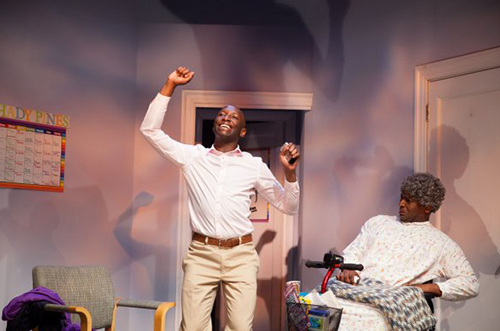In some ways, Bootycandy is a wild fantasy. Robert O’Hara’s latest play, now at Playwrights Horizons, just keeps breaking storytelling conventions, so that every time we think we understand it, it dodges and weaves.
For instance, we might start with a sitcom-style scene about a little boy and his mother, but in a just a few minutes we’ll see an erotic moment between two men flirting in a bar. We might see two women hollering about a baby with a ridiculous name, but soon enough, the action transitions to a playwrights’ conference, where the “authors” of the very scenes we’ve been watching are asked to explain themselves.
But while Bootycandy is certainly raucous, it’s never messy. O’Hara, who also directs, is tackling the experience of being a gay black man in America, and by juxtaposing so many theatrical styles, he’s suggesting there’s no tidy way to confront such a huge subject. If a character like Sutter, who journeys from confused youth to conflicted adulthood, lives in a play that’s outlandish and contradictory and ferocious, well… maybe that’s how things are for the real-life Sutters of the world.
The actors might agree. For them, this fantastical show is also realistic. At least emotionally.
“Robert told us that no one in the play makes a joke,” says Phillip James Brannon, who plays Sutter. “All these things are the truth to them. Yes, there are ridiculous things being said, and there are ridiculous costumes and wigs. But you let them be and you just tell the truth. It turns into something else if we’re too aware.”
Lance Coadie Williams echoes that idea. He plays multiple characters, including a reverend who comes out (in drag) to his congregation, and he says that with each version of Bootycandy, he’s gotten more in touch with the authenticity of his roles. (Like Brannon, he was in previous productions in D.C. and Philadelphia.)
“With the preacher, I remember taking the sides at the audition and throwing them across the room when I revealed myself,” Williams says. “When I met Robert, he threw in some notes and said, ‘This man is totally convinced that what he has to say is real. He’s here to prove a point. So don’t play the anger. Play the reality in teaching a point.”
That spirit helps the cast connect to the crowd in key scenes, like when Sutter speaks directly to the room about his playwriting. Brannon says, “I’m looking at the audience and really trying to look people in the eyes. Not in an intimidating way, but just treating them like they’re supposed to be there. I like that stuff. I think it forces you to be even more honest because people can always sense it when you’re not.”
After performing the show so many times, Williams has even expanded his understanding of why he’s on stage. Discussing the preacher’s coming out speech, he says, “Instinctually, as an artist, I really was just throwing myself into the work. But now having some shows underneath me, I can carve out the story more and personalize it more. Maybe there’s a choir boy in there who needs to hear that sermon. Maybe there’s somebody in that audience who needs to hear exactly what I’m saying, and if it’s one person that’s changed, that walks away with something, then my job is done.”
—
Mark Blankenship is TDF’s online content editor
